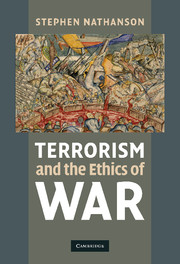Book contents
- Frontmatter
- Contents
- Acknowledgments
- Introduction
- PART I TERRORISM: WHAT'S IN A NAME?
- 1 The problem of defining terrorism
- 2 Defining terrorism
- 3 What makes terrorism wrong?
- 4 Innocence and discrimination
- 5 “Who dun it” definitions of terrorism
- Conclusion: taking stock
- PART II WHY MORAL CONDEMNATIONS OF TERRORISM LACK CREDIBILITY
- PART III DEFENDING NONCOMBATANT IMMUNITY
- PART IV HOW MUCH IMMUNITY SHOULD NONCOMBATANTS HAVE?
- Conclusion: terrorism and the ethics of war
- Bibliography
- Index
1 - The problem of defining terrorism
Published online by Cambridge University Press: 05 June 2012
- Frontmatter
- Contents
- Acknowledgments
- Introduction
- PART I TERRORISM: WHAT'S IN A NAME?
- 1 The problem of defining terrorism
- 2 Defining terrorism
- 3 What makes terrorism wrong?
- 4 Innocence and discrimination
- 5 “Who dun it” definitions of terrorism
- Conclusion: taking stock
- PART II WHY MORAL CONDEMNATIONS OF TERRORISM LACK CREDIBILITY
- PART III DEFENDING NONCOMBATANT IMMUNITY
- PART IV HOW MUCH IMMUNITY SHOULD NONCOMBATANTS HAVE?
- Conclusion: terrorism and the ethics of war
- Bibliography
- Index
Summary
For decades prior to the September 11 attacks, a frustrating debate went on about the definition of terrorism. The mere existence of this debate presents a serious challenge to the claims of moral clarity associated with proponents of the “war on terrorism.” How can we know that terrorism is always wrong if we can't say what it is? The confusions generated by the definition debate are nicely captured in remarks by Christopher Joyner. He writes:
Politically, academically, and legally, the phenomenon of terrorism eludes clear and precise definition. In a real sense, terrorism is like pornography: You know it when you see it, but it is impossible to come up with a universally agreed-upon definition. The hackneyed bromide “One man's terrorist is another man's freedom fighter” still remains a truism in international political perceptions. “Terrorism” lies in the eye of the beholder.
Three competing views appear in Joyner's account: the confident claim that we know terrorism when we see it, the distressing idea that it is impossible to agree on a definition of terrorism, and the surprising conclusion that terrorism has no objective reality but exists only “in the eye of the beholder.”
The second and third points shake the moral clarity view at its foundations, criticizing its proponents for literally not knowing what they are talking about. But they also challenge anyone who believes that terrorism is wrong to “put up or shut up.” Either we should define terrorism or we should keep our condemnations to ourselves.
- Type
- Chapter
- Information
- Terrorism and the Ethics of War , pp. 11 - 23Publisher: Cambridge University PressPrint publication year: 2010



